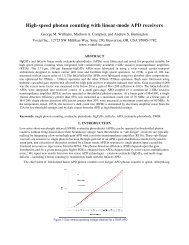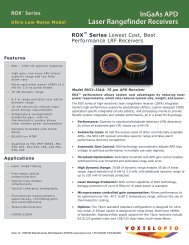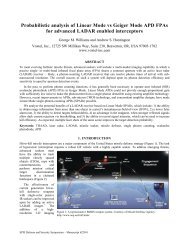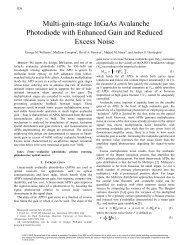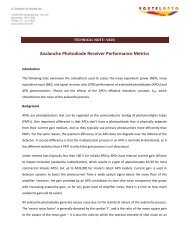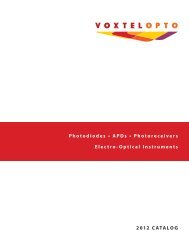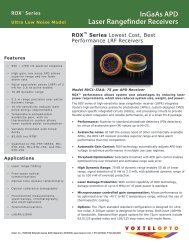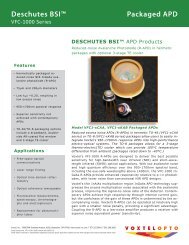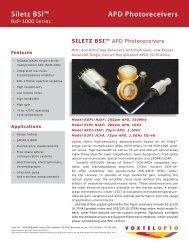Characterization of HgCdTe MWIR Back-Illuminated II-VI-07 ... - Voxtel
Characterization of HgCdTe MWIR Back-Illuminated II-VI-07 ... - Voxtel
Characterization of HgCdTe MWIR Back-Illuminated II-VI-07 ... - Voxtel
- No tags were found...
Create successful ePaper yourself
Turn your PDF publications into a flip-book with our unique Google optimized e-Paper software.
current and dark current plus dc photocurrent versus bias voltage by the method described in our previous<br />
papers (Ref. 3-4).<br />
ARRAY CHARACTERIZATION DATA<br />
Dependence <strong>of</strong> Gain on Cut<strong>of</strong>f Wavelength<br />
Fig. 2 shows data for gain versus reverse bias voltage, for T=160 K, for the two films from our<br />
previous work 3,4 along with new gain data for a third film with a longer cut<strong>of</strong>f wavelength. The gain data for<br />
this new film show the same behavior as we reported for the first two films: an exponential increase in gain<br />
with reverse bias, and excellent uniformity <strong>of</strong> gain from element to element. As expected, the gain at a given<br />
bias voltage is higher for the new film with the longer cut<strong>of</strong>f wavelength.<br />
Fig. 2 shows that there is reasonably good agreement between our M(V) data at 160 K for these three<br />
films and the empirical model <strong>of</strong> Beck 1 (dashed curves) for avalanche gain M(V) in <strong>HgCdTe</strong> e-APDs:<br />
M(V)<br />
= 1+<br />
2<br />
[2(V−V<br />
th ) / Vth<br />
]<br />
, Vth<br />
= 6.8 ×<br />
E<br />
G<br />
(1)<br />
where the values for the energy band gap E G that appear in the equation for the threshold voltage V th were<br />
calculated from the measured cut<strong>of</strong>f wavelengths λ CO for the three films with the usual relationship<br />
E G =hc/λ CO . Beck’s model has only one adjustable parameter, the constant <strong>of</strong> proportionality between the<br />
threshold voltage V th and the energy gap E G . Beck uses a value <strong>of</strong> 6.8 to fit their M(V) data at T=77 K for<br />
their front-illuminated “p-around-n” <strong>HgCdTe</strong> e-APDs with cut<strong>of</strong>f wavelengths ranging between 2.6 µm and<br />
10.8 µm. The plots <strong>of</strong> Beck’s model in Fig. 2 (dashed curves) are done with this same value <strong>of</strong> 6.8.<br />
Dark Current at F/5 and FOV=0<br />
Fig. 3 shows I(V) data for a 250×250 µm² photodiode taken at 80 K for both F/5 and FOV=0<br />
conditions. Also shown are I(V) data for F/5 with the device illuminated by a 1000 K unfiltered blackbody,<br />
from which gain was determined. Gain data are plotted on the right-hand axis. At -10.0 V the gain is 3<strong>07</strong>,<br />
about a factor <strong>of</strong> two higher than the gain <strong>of</strong> 150 at 160 K, shown in Fig. 2, measured for the same bias<br />
-9-




